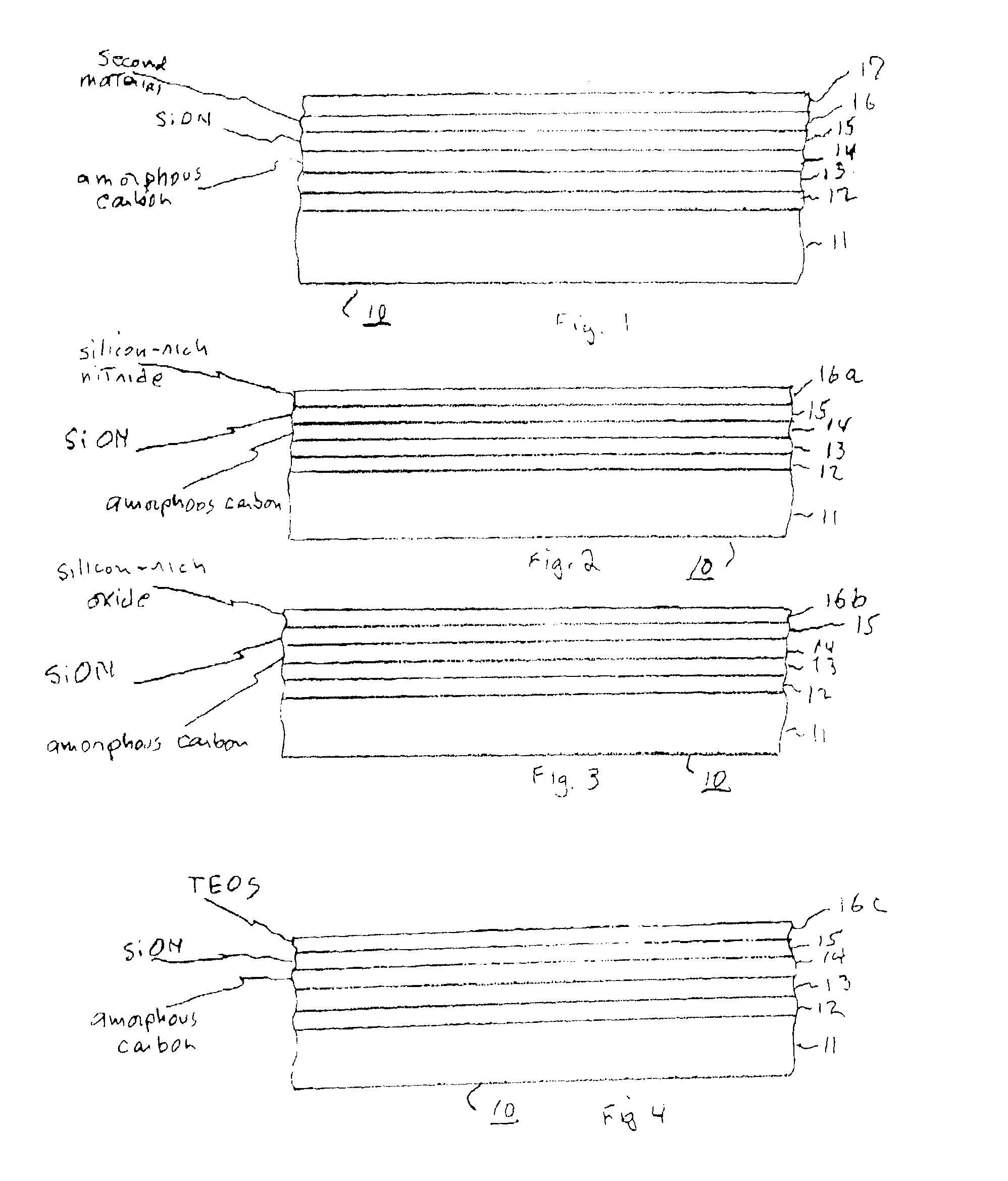Capping layer for reducing amorphous carbon contamination of photoresist in semiconductor device manufacture; and process for making same
- Summary
- Abstract
- Description
- Claims
- Application Information
AI Technical Summary
Benefits of technology
Problems solved by technology
Method used
Image
Examples
example 1
[0023]In FIG. 2, a capping stack buildup consisting of SiON layer 15 and a second material comprising silicon-rich nitride layer 16a is formed on top of amorphous carbon layer 14. The SiON may be placed either on top of the silicon-rich nitride layer 16a or below it. Deposition of SiON is effected by flowing 3–6 liter / min N2, 100–300 sccm SiH4 gas, and 50–300 sccm N2O gas. The plasma is maintained at 350–500 degrees C. and at 3–8 Torr pressure. RF plasma power is maintained at between 250 and 500 Watts. With these conditions, typical deposition rates of SiON are 30–150 A / sec. These process parameters may be varied to achieve the desired control over the deposition thickness and optical properties. Specifically, the layer 15 of SiON suitable for 193 nm photoresist system is 200 nm in thickness and with optical values n=1.8±0.10 and k=0.3±0.05. These values are optimal because of the resulting low reflectivity leading to minimal CD swing and thereby better CD control and uniformity ov...
example 2
[0024]In FIG. 3, a capping stack buildup consisting of SiON layer 15 and a second material comprising silicon-rich oxide layer 16b is formed on top of amorphous carbon layer 14. The SiON is deposited as in Example 1. To deposit silicon-rich oxide, SiH4 gas is flowed at 50–300 sccm, N2 gas is flowed at 1–2 liter / minute, and N2O gas is flowed at 100 cc–7 liters / minute. Pressure of 800 mT to 3 Torr, wafer temperature of 350–500 degrees C., and plasma power between 250–600 watts are maintained. As in Example 1 process parameters are varied to achieve desired control over the deposition thickness and optical properties. Thus layer 16b of silicon-rich oxide film suitable for the reflectivity requirements of a 193 nm photoresist process, is approximately 200 Angstroms thick, although thickness can vary between about 50 to 200 Angstroms. Layer 16b is produced with optical values of n=1.75±0.10 and k=0.2±0.2v. These are optimal because of the resulting low reflectivity leading to small CD sw...
example 3
[0025]In FIG. 4, a capping stack buildup is realized consisting of an SiON 15 and a second material comprising TEOS oxide layer 16c (oxide deposited using Tetra Ethyl Ortho Silicate precursor). The SiON is deposited as in Example 1. Then, either above or below the SiON layer 15, the layer 16c of TEOS oxide is deposited. The deposition of TEOS oxide in the PECVD process is conventional using well-known TEOS precursors. Again, process parameters are varied to achieve desired control over the deposition thickness and optical properties. A layer of TEOS oxide film suitable for the 193 nm photoresist process is approximately 250 Angstroms thick, but may vary in thickness from about 150 to 300 Angstroms; and has values of n=1.67±0.07 and k=0.1±0.1v.
[0026]In summary, the capping stacks exemplified above enable the requisite low reflectance to be obtained in the layers below the photoresist, while keeping the amorphous carbon and the photoresist separated more effectively through the multip...
PUM
 Login to View More
Login to View More Abstract
Description
Claims
Application Information
 Login to View More
Login to View More - R&D
- Intellectual Property
- Life Sciences
- Materials
- Tech Scout
- Unparalleled Data Quality
- Higher Quality Content
- 60% Fewer Hallucinations
Browse by: Latest US Patents, China's latest patents, Technical Efficacy Thesaurus, Application Domain, Technology Topic, Popular Technical Reports.
© 2025 PatSnap. All rights reserved.Legal|Privacy policy|Modern Slavery Act Transparency Statement|Sitemap|About US| Contact US: help@patsnap.com


